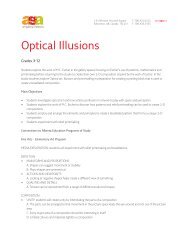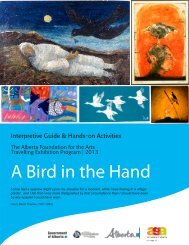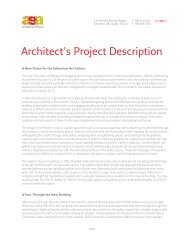Down on the Farm - Art Gallery of Alberta
Down on the Farm - Art Gallery of Alberta
Down on the Farm - Art Gallery of Alberta
- No tags were found...
You also want an ePaper? Increase the reach of your titles
YUMPU automatically turns print PDFs into web optimized ePapers that Google loves.
The <strong>Alberta</strong> Foundati<strong>on</strong> for <strong>the</strong> <strong>Art</strong>s Travelling Exhibiti<strong>on</strong> ProgramCyanotype Printing 7-12BackgroundThe cyanotype (blue image <strong>on</strong> a white ground) is an old photographic process using chemicalsavailable from scientific chemical companies. It works well <strong>on</strong> paper and natural fibers likecott<strong>on</strong>, silk and canvas. Most familiar from timeless botanical prints, architectural drafts knownas “blue prints” or kindergarten science experiments, <strong>the</strong> cyanotype printing process deservesto be taken out <strong>of</strong> <strong>the</strong> dark ages. This is a fun cyanotype project using limited dollars, time,facilities and experience.Cyanotype printing is essentially printing with shadows. Weuse black paint to create dark shapes that block <strong>the</strong> sunlightfrom hitting <strong>the</strong> fabric. Images we paint will appear as white<strong>on</strong> <strong>the</strong> fabric because <strong>the</strong> blue sensitizer cannot turn bluebecause <strong>of</strong> <strong>the</strong> image shadow. Exposure times will varyaccording to geographical locati<strong>on</strong>, seas<strong>on</strong> and time <strong>of</strong> day,usually from 8-30 minutes.Unlike traditi<strong>on</strong>al print photography development, <strong>the</strong>re is n<strong>on</strong>eed for a real “dark room.” The cyanotype sensitizer is notnearly as light sensitive, so any room lit <strong>on</strong>ly with regular lightbulbs will be fine. We call this <strong>the</strong> “dim room.” You will als<strong>on</strong>eed a “light room”. This is an outdoor space large enoughfor <strong>the</strong> fabric to lay flat outside without intruding shadows. Wemake <strong>the</strong> “film positive” larger than <strong>the</strong> fabric to lay over <strong>the</strong>edges for seamless printing and <strong>the</strong>n use small straight pins topress <strong>the</strong> film positive <strong>on</strong> to <strong>the</strong> fabric with sensitizer and <strong>the</strong>black cloth.Woodland Horsetail(Equisetum sylvaticum)Anna Atkins (1799-1871)Materials• 2 yards x 36” black canvas• Clear Acetate Roll .003” 25” × 12 fthttp://www.dickblick.com/1/1/60262-25-12-ft-003-grafix-clear-acetate-rolls.html• Measuring tape• Scissors• Drafting tape (opti<strong>on</strong>al)• Liquid black acrylic paint or India ink• ¼ “ paint brush or bamboo calligraphy brush• Printing paper or fabric with sensitizer http://www.blueprints<strong>on</strong>fabric.com/store.php?cat=8• (20-30) 3/4” flat head straight pins• 4 weights or ink cans• Wash basin• 4 oz hydrogen peroxide (opti<strong>on</strong>al)AFA Travelling Exhibiti<strong>on</strong> Program, Edm<strong>on</strong>t<strong>on</strong>, AB. Ph: 780.428.3830 Fax: 780.421.0479youraga.ca
















